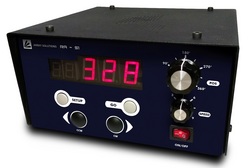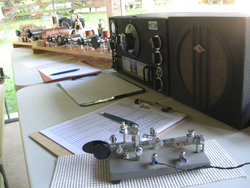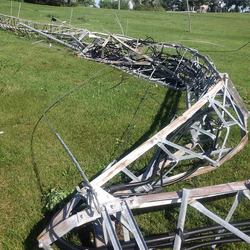 June 29, 2016 Editor: Paul Bourque, N1SFE | ||||
IN THIS ISSUE
This Thursday evening to Friday evening in the US time zones, there will be plenty of activity in the RAC Canada Day contest. Commemorating Canada's Confederation, CW and phone modes are encouraged, including AM and FM on bands where appropriate. Check out the 2016 rules, then plan your operation. For four hours on Friday evening, you can work on your CW in the FISTS Slow-speed Sprint. Speeds 13 WPM and slower are encouraged, and a log submission could earn you a prize. As July 2 and 3 is Independence Day weekend, the domestic contest calendar is otherwise light. The weekend of July 9 and 10, the IARU HF Championship contest will be prime. CW and Phone can be used, singly or mixed, depending on your entry category. Remember that if you're entering multi in this contest, only one transmitted signal is allowed at a time. IARU Headquarter stations, ITU zones, and certain IARU personnel are multipliers. For a downloadable list of the 2016 IARU Headquarter stations, see the item in the News section below. NG3K requests that if you're participating in the RSGB IOTA 2016 contest using a special call sign, or will be fielding a DXpedition, to please provide this information to his website, so that it can be announced to the IOTA list. BUSTED QSOS Jonesy, W3DHJ, noted that I typo'd Radio in the last issue, but was kind enough to leave open the possibility that I meant "Whirling" in Malagasy. Complete information for all contests follows the Conversation section June 30 July 1 July 2
July 3 July 4 July 5 July 6 July 7 July 8 July 9 July 10 July 13 If you're participating in the IARU Contest July 9 and 10, you can find a list of IARU headquarter stations compiled and publicized by Joe, OZ0J and Bob, N6TV. At the time of this writing, the link still points to 2015 stations. It will be updated with 2016 information in the next few days. Make sure that you download the most up to date version just before contest start, as changes are likely.
Array Solutions has announced two new products that may be useful in an automated contest station. The RA-S1 Universal Digital Rotator controller claims manual or automatic control of nearly any rotator brand and model. Manual positioning is possible via knob and button, and it can also be controlled via the popular Yaesu G232A protocol through the built-in serial or USB port. The RAM-34 Pre-amplifier system is designed to make operation on 160 meters through 40 meters easier, more reliable, and more controllable by combining switching, filtering, preamplification, and attenuation functions into one unit. Settings can be kept per-band, and functionality is also controllable via the Shacklan network interface. Imagine if you could drop by the shacks, or garages, of some amateur radio operators that are specialists in a particular area, for example contesting, of VHF/UHF operation, and you could ask them anything you like. This is the concept behind the monthly paid website QSOTodayCommunity.com. Randy, K5ZD, is currently taking contest-related questions. Scientists have found bacteria that directly live off of electricity. They were found by looking in locations that are rich in minerals, but poor in typical bacterial foodstuffs, for example a gold mine. Now, if we can just get them to copy CW! Scott, N3FJP, announces the availability of Amateur Contact Log 5.6, as well as updates to all his contest logging programs. The list of new features and capabilities is long, and includes improvements in API functionality and the sharing of CW sending between applications. Of particular note to contesters is Scott's explanation of his change of opinion on call history databases, resulting in implementation of call history functions. You can read all about it in his announcement. Bizarre lightning phenomena have occasionally been described in discussions involving antennas, towers, and grounding. One type is 'ball lightning' which generally describes an observation of a spherical glowing shape of light associated with traditional lightning conditions. Hypotheses have been developed that link the cause of ball lighting to plasmas or clouds of very small particles, and a new article in Nature proposes that ball lightning consists of confined bubble of intense microwave radiation. If ball lightning is explained by this theory, protecting against it would present challenges beyond those of conventional lightning. Ball lightning has been observed to pass through glass, form inside of closed rooms, or inside of metal-skinned aircraft. Additional protective measures would be necessary to deal with any strong microwave component. Bob, K8IA, analyzed the values of the exchange used by operators he worked in the recent All Asian DX CW Contest. As this number is supposed to be the age of the operator, it appears to mirror the operator age demographics noted by the CQ WW Contest survey. The Potomac Valley Radio Club (PVRC) recently received an ARRL Certificate of Merit for Outstanding Service to the Amateur Radio Community. ARRL Section Manager Marty Pittinger, KB3MXM, presented the award to PVRC President Bud, W3LL, with Tom Abernethy, W3TOM, ARRL Atlantic Division Director in attendance. Dave, K1NYK, enjoyed the positive tone in the recent ARS Technica article on Amateur Radio, which likened characteristics of our community to members of the Maker movement. Pack Roving Pack Roving is a technique that mobile or portable VHF/UHF contest stations use to take advantage of particular multiplier scoring rules in a contest. It involves multiple rover stations moving in concert and making contacts with one another while visiting new grid squares. Depending on a particular contest's rules, if four rovers each visit a different grid square, work each other, then change position to a new grid square six times, each rover could earn six multipliers plus eighteen contacts per band. Some contests also count grid square visits as a multiplier. As rovers are often equipped with multiple bands, scores can add up quickly. Roving techniques and contest rules have co-evolved through the years. The Southern California Contest Club has used this technique with great success, and N6NB's roving website provides some historical perspective.
Eric, NO3M, built a replica 1930's era transmitter from scratch for 2016 field day, and was using it under the call W8CDX. Featuring a four-tube exciter and 203A amplifier stage, he eventually achieved over 100 watts output. One cannot help thinking that we take modern gear too much for granted as he describes using hand capacitance to zero-beat the transmitter to the stations worked. Eric's article includes links to additional pictures, and WA3TTS's video of the transmitter in operation. Eric and friends had such a blast that they're going to be adding 20 and 80 meters next year, and operate the entire weekend.
This is a sight you do NOT want to see. Frank, W3LPL, experienced an EF0 tornado on June 21, which caused the failure of this 200-foot AB-105 tower. Frank intends to have its replacement in the air by the fall. The 2015 ARRL RTTY Roundup and 2015 ARRL 10 meter Full Results articles had minor changes which are now reflected on the website. New scores have been incorporated into the qualification standings for WRTC-2018. IARU Region 1 Field Day scores have been taken into account. Shorten your CQs Under most circumstances, keep your CQs brief. Any potential callers are going to tune to your frequency, hear your CQ message, and decide whether to call you based on how workable you are. Workability is subjective. Unless you're a multiplier or valuable in points, potential callers probably won't hang around for slow or sloppy sending, or anything that indicates the potential to waste time, like a long CQ. Time is rate, after all. There are times to have a longer CQ, such as when you need to get spotted by the RBN, or when on RTTY using 75 WPM Baudot and the short CQ message time may be too short to allow callers to get zero beat. RemoteQTH.com has a new modular antenna switch kit that could be useful in your station-building activities. By combining multiple modules, it can scale in the number of antennas or in the number of transceiver to what the application requires. Trung, W6TN, details how a Mumble server can be set up to serve audio from a remote radio, in the context of accessing a remote Elecraft KX3 from a mobile phone. A Mumble audio server could be a component you need for your remote station. Adding wireless network capability to some of our serial-attached contest gear is easier with inexpensive chips like the ESP8266. There's a wealth of information now available on how to utilize this chip, and one person went so far as to WiFi enable his Fluke Multimeter. With 6-26 MHz coverage, Tim, K3HX, suggests with tongue firmly in cheek that one of these 200-ton monster antennas (PDF) would make for a memorable 2017 Field Day. The Senior Director of Audio Engineering for NPR suggested a method for not allowing changes to certain microphone settings: using epoxy to make the setting permanent. The complete interview also discusses other details which broadcasters are concerned about in a 'commercial' environment. Building on LOTW Here's something I've not heard lately with regards to ARRL Logbook of the World (LOTW) usage: "It's too hard to set up and use." Sure, there were teething pains. In those early days, some of the concepts and details needed to set up and maintain the chain of trust for QSO confirmations were new and unfamiliar. My perception in speaking with other hams is the complaints have diminished as LOTW utility and benefits have become apparent. Most of us didn't realize it at the time, but amateurs were on the cutting edge of technology when we used LOTW, as the procedures LOTW uses for signing and uploading are essentially the same thing that many people now casually use years later for electronic signing of documents. Perhaps the earliest enthusiastic contest supporters of LOTW were RTTY operators. In the first few years of LOTW operation, I recall being very impressed that a double-digit percentage of my ARRL RTTY Roundup QSOs were confirmed when I uploaded my log five hours after the contest ended. The LOTW log submission process has been made even easier over time by the excellent built-in support of logging programs. Whether in batches or contact-by-contact, it's become nearly effortless to get contacts into LOTW once the setup has been done in your logging program. With millions of confirmed QSOs now in the LOTW database, we're beginning to see non-ARRL entities using LOTW information as the 'ground truth' for certificates and achievements. They're doing so by using LOTW's programming interfaces with appropriate credentials to 'view' QSO information. One example of this is Deutscher Amateur Radio Club (DARC)'s WRTC-2018 Worked WRTC Qualification Regions Award, which for the years 2015, 2016, and upcoming 2017 recognizes confirmed contacts with the 29 WRTC Qualification Regions. Rather than requiring what could be tedious record keeping, uploading, and submission, by allowing the DARC Community Logbook site to access your LOTW records the process is streamlined, as LOTW is directly queried for qualifying contacts.
That's all for this time. Remember to send contesting related stories, book reviews, tips, techniques, press releases, errata, schematics, club information, pictures, stories, blog links, predictions, and radio-related jokes to contest-update@arrl.org 73, Brian N9ADG 30 Jun - 13 Jul 2016 An expanded, downloadable version of QST's Contest Corral in PDF format is available. Check the sponsor's Web site for information on operating time restrictions and other instructions. HF CONTESTS CWops Mini-CWT Test, Jun 30, 0300z to Jun 30, 0400z; CW; Bands: 160, 80, 40, 20, 15, 10m; Member: Name + Member No., non-Member: Name + (state/province/country); Logs due: July 2. VHF+ CONTESTS See SKCC Weekend Sprintathon and RAC Canada Day events, above June 30, 2016 July 1, 2016 July 3, 2016 July 4, 2016 July 6, 2016 July 10, 2016 July 11, 2016 July 12, 2016 July 13, 2016 ARRL Information Click here to advertise in this newsletter, space subject to availability. Your One-Stop Resource for Amateur Radio News and Information ARRL membership includes QST, Amateur Radio's most popular and informative journal, delivered to your mailbox each month. Subscribe to NCJ - the National Contest Journal. Published bimonthly, features articles by top contesters, letters, hints, statistics, scores, NA Sprint and QSO Parties. Subscribe to QEX - A Forum for Communications Experimenters. Published bimonthly, features technical articles, construction projects, columns and other items of interest to radio amateurs and communications professionals. Free of charge to ARRL members: Subscribe to The ARRL Letter (weekly digest of news and information), the ARES E-Letter (monthly public service and emergency communications news), Division and Section news -- and much more! ARRL offers a wide array of products to enhance your enjoyment of Amateur Radio. Visit the site often for new publications, specials and sales. Donate to the fund of your choice -- support programs not funded by member dues! Reprint permission can be obtained by sending email to permission@arrl.org with a description of the material and the reprint publication. ACKNOWLEDGEMENTS ARRL Contest Update wishes to acknowledge information from WA7BNM's Contest Calendar and SM3CER's Contest Calendar. | ||||









